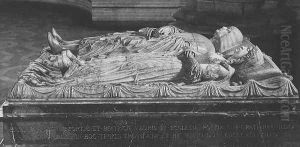Bambaia Paintings
Agostino Busti, better known as Bambaia, was a prominent Italian sculptor of the High Renaissance, originating from Milan. Born around 1480, Bambaia's work is often characterized by its intricate detail, elegant figures, and the incorporation of classical themes, reflecting the Renaissance's revival of ancient art. Despite the scarcity of detailed records about his life, Bambaia's contributions to sculpture, especially in Lombardy, have established him as a significant figure in the history of Italian art.
Bambaia's career is mostly documented through his remarkable works rather than comprehensive biographical records. He is renowned for his elaborate funerary monuments, which include the tomb of Gaston de Foix in the church of Santa Marta in Milan, completed around 1515. This masterpiece showcases Bambaia's skill in creating dynamic compositions and his ability to work with marble, which was highly regarded by his contemporaries. His style is notable for its delicate details, elaborate drapery, and the use of classical motifs, aligning him with the principles of the High Renaissance, yet his work also hints at the emerging Mannerist style with its complexity and elegance.
Throughout his career, Bambaia also contributed significantly to the decorative arts, producing altarpieces and smaller religious sculptures that were admired for their intricate detail and emotional expressiveness. Despite the challenges of the period, including the Sack of Rome in 1527 and the shifting political landscapes of Italian city-states, Bambaia's work remained influential. His legacy is seen in the works of subsequent generations of sculptors in Northern Italy, who continued to draw inspiration from his innovative approach to form, detail, and composition.
Bambaia's death is believed to have occurred around 1548, yet his exact date of death remains uncertain, as does much of his life outside of his artistic production. Today, Bambaia's sculptures can be found in various museums and collections, serving as a testament to his mastery and the enduring appeal of his art. Through his contributions, Bambaia played a key role in the development of Renaissance sculpture, bridging the gap between the classical revival of the early Renaissance and the more expressive, dynamic approaches that would come to define the later periods of the movement.

